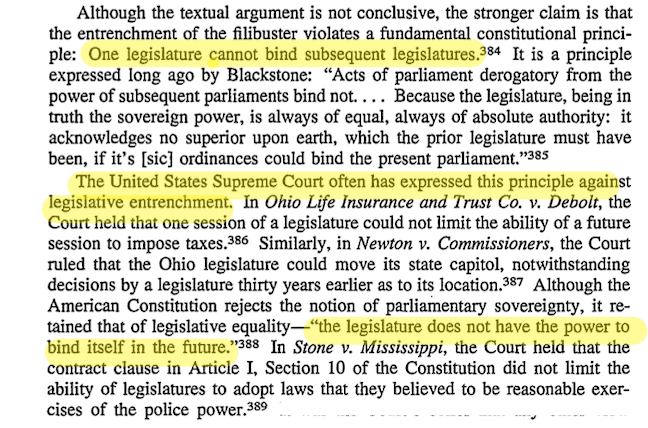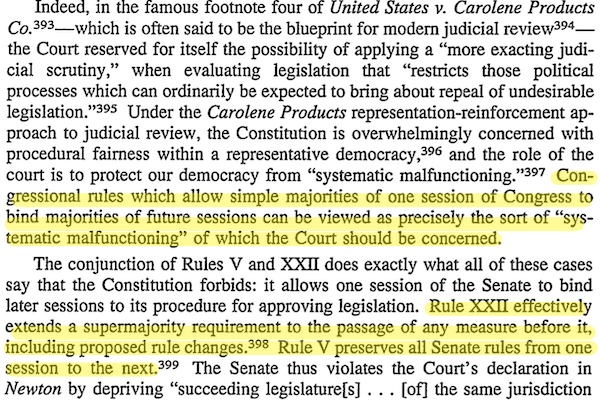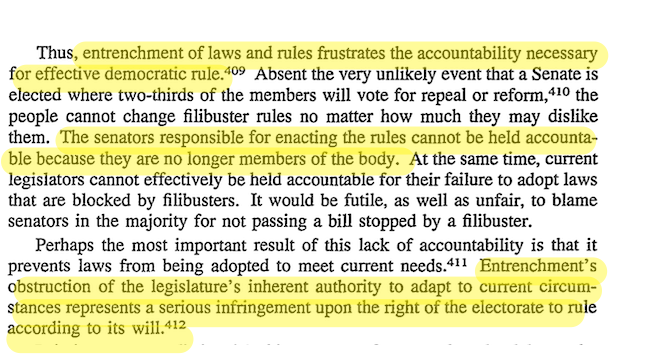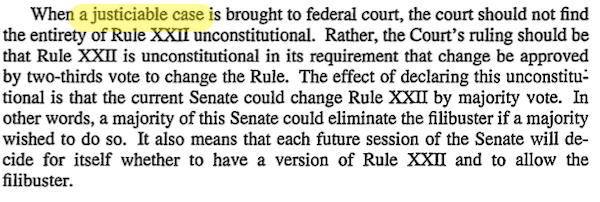By Lambert Strether of Corrente.
The filibuster has been much in the news lately, either as the barrier to Democrats over-riding the Supreme Court’s decision in Dobbs v. Jackson Women’s Health Organization, which overturned Roe v. Wade, or as a barrier to other putative agenda items where Democrats could (notionally) get a simple majority, but not the supermajority of 60 needed to end a filibuster: packing the court, a Green New Deal, etc. Here President Biden gives nominal support to ending the filibuster:
We have to codify Roe vs. Wade into law.
If the filibuster gets in the way, we should provide an exception to the filibuster to deal with the Supreme Court decision.
— Joe Biden (@JoeBiden) June 30, 2022
Unsurprisingly, however, Biden declared himself impotent two days later:
Pres. Biden said Congress needs to act to codify Roe v. Wade into law but that “right now, we don’t have the votes in the Senate to change the filibuster.”
“We either elect federal senators who will codify Roe, or Republicans who will … try to ban abortions nationwide.” pic.twitter.com/TVsu2NqdnI
— CBS News (@CBSNews) July 1, 2022
Biden may be, of course, genuinely impotent just now: Senator Leahy is out of commission with a broken hip. Then too as always President Manchin and Kristen Simena would need to be brought on board. One sighs for the days when Presidents knew how to muscle the Senate:
58 years ago today, LBJ signed the Civil Rights Act into law because he played hardball and got past the filibuster. pic.twitter.com/4wlWvLTfGI
— Nina Turner (@ninaturner) July 3, 2022
We should, of course, not forget that the Democrat Party did not become what it is through a random process. As I wrote:
The Democrat Party was constructed. It is the way that it is because that’s how its leadership wants it. it’s more auto-kinbaku-bi; the Democrat jouissance from tying themselves up, and rendering rhemselves helpless (filibuster; Parliamentarian; moderates). It’s not merely pragmatic; I swear they actually get a thrill, a guilty pleasure, out of it.
When you read the section on the Senate rules, you will see a fine example of auto-kinbaku-bi, albeit a bipartisan one. With that I will leave the politics of the day behind.
Back in 2012, I wrote a post on the filibuster: “The Obama Enabler’s Big Lie: “We Never Had the Votes,” meaning the 60 votes needed to pass a cloture motion and end a filibuster. I showed there were two ways to get the votes by removing the 60 vote supermajority and replacing it with a simple majority: during a session, using tricky procedural maneuvering (“the nuclear option”), or at the start of a session, when the Senate bootstraps itself (“the Constitutional option”)
That conclusion still holds, but I wish to go the same ground in more detail. First, I will go through actual sources on Senate procedure, hoisted from a long comment inspired by a question from alert reader Fraibert, (These procedures are complicated — the Bourbons of Louis XVI’s day would would loved them — and I hope I’ve gotten them right. No doubt there is an expert on Senatorial arcana in the leadership who will correct me.) I will also point out where “the nuclear option” has been used, and could be again, were there the political will. Next, I will go through the reasons that some conservatives give for leaving the Senate, as a deliberative body, as it is. Finally, I will introduce the concept of “entrenchment,” an obscure tactic I’ve dubbed the “thermonuclear option,” which would assault the Senate’s very sense of itself as a “continuing body.” I’ll conclude with a brief remark on the politics of the current situation.
Senate Rules on the Filibuster
There’s a lot to unpack here. First, the Senate does indeed have standing rules:
The legislative process on the Senate floor is governed by a set of standing rules, a body of precedents created by rulings of presiding officers or by votes of the Senate, a variety of established and customary practices, and ad hoc arrangements the Senate makes to meet specific parliamentary and political circumstances. A knowledge of the Senate’s formal rules is not sufficient to understand Senate procedure, and Senate practices cannot be understood without knowing the rules to which the practices relate.
So, arcane. Nevertheless, when a new Congress begins:
The Senate follows a well-established routine on the opening day of a new Congress. The proceedings include… adopting administrative resolutions, for the new Congress….
In other words, the standing rules don’t simply carry over, as if they were defaults (see also Senator Byrd below at “dead hand”). They must be explicitly adopted at the start of a session. (I would speculate that’s one reason why the Manual of the Senate is often updated..)
There are, then, two occasions on which the filibuster might be altered or abolished. (In what follows, in quoting Senate rules, I will cite to the “Senate Manual” from the 116th Congress (2019 – 2020), found here).
(1) When a Senate session begins, by majority vote> (the “Constitutional Option”). From a history of the filibuster by the Congressional Research Service:
The Senate, exclaimed Senator Byrd, no longer had an effective Rule XXII [the filibuster rule]. He set about to revise Senate procedures on the opening day of the 96th Congress (1979-1980).
On January 15, Senator Byrd introduced a resolution, S. Res. 9, that proposed general reforms (e.g., the installation of an electronic voting system in the chamber), as well as others focused on post-cloture procedures. However, many Republican Senators believed that the changes proposed by Senator Byrd would reduce the role of the minority in the legislative process. To promote bipartisan collaboration and compromise, the two party leaders (Byrd and GOP leader Howard Baker of Tennessee) created an ad hoc committee to develop a mutually acceptable way to consider Byrd’s reform proposals. The key recommendation that emerged from the discussions was for the Senate to consider separately the post-cloture reforms embedded in S. Res. 9. On February 7, Senator Byrd submitted a resolution (S. Res. 61) that dealt only with post-cloture procedures.
Noteworthy is that on January 15, Majority Leader Byrd had made clear to his Senate colleagues that it was imperative for the Senate to deal with the postcloture filibuster because it thwarts “the will not only of a majority but of a three-fifths majority of the Senate, which, having voted for cloture signifies its will that the debate shall come to a close and that the pending matter shall be acted upon one way or the other.”315 If a unanimous consent agreement to address changes to the post-cloture filibuster was unattainable, Senator Byrd said that he would employ the constitutional option—”in essence upholding the power and right of a majority of the Senate to change the rules of the Senate at the beginning of a new Congress.” Moreover, he dismissed the view that the Senate’s rules continue from one Congress to the next unless they are changed in accordance with those rules. “That [Senate] rule was written in 1959 by the 86th Congress. The 96th Congress is not bound by the dead hand of the 86th Congress.” He went on to state:
The Senate of the 86th Congress could not pretend to believe that all succeeding Senates would be bound by the rules that it had written. It would be just as reasonable to say that one Congress can pass a law providing that all future laws have to be passed by a two-thirds vote. Any Member of this body knows that the next Congress would not heed that law and would proceed to change it and would vote repeal by a majority vote.
I am not going to argue the case any further today, except to say that it is my belief—which has been supported by rulings of Vice Presidents of both parties and by votes of the Senate—in essence upholding the power and right of a majority of the Senate to change the rules of the Senate at the beginning of a new Congress.
Note that this procedure was not carried out; Byrd’s threat was enough. I believe that Byrd’s mastery of arcana would make his views authoritative even today.
(2) When the Senate is in session, by creating a new precedent (the “Nuclear Option”). Fortunately we have a method translated into lay language, together with proof that this technique has been used successfully twice. From the Brookings Institution:
A more complicated, but more likely, way to ban the filibuster would be to create a new Senate precedent. The chamber’s precedents exist alongside its formal rules to provide additional insight into how and when its rules have been applied in particular ways. Importantly, this approach to curtailing the filibuster—colloquially known as the “nuclear option” and more formally as “reform by ruling”—can, in certain circumstances, be employed with support from only a simple majority of senators.
The nuclear option leverages the fact that a new precedent can be created by a senator raising a point of order, or claiming that a Senate rule is being violated. If the presiding officer (typically a member of the Senate) agrees, that ruling establishes a new precedent. If the presiding officer disagrees, another senator can appeal the ruling of the chair. If a majority of the Senate votes to reverse the decision of the chair, then the opposite of the chair’s ruling becomes the new precedent.
In both 2013 and 2017, the Senate used this approach to reduce the number of votes needed to end debate on nominations. The majority leader used two non-debatable motions to bring up the relevant nominations, and then raised a point of order that the vote on cloture is by majority vote. The presiding officer ruled against the point of order, but his ruling was overturned on appeal—which, again, required only a majority in support. In sum, by following the right steps in a particular parliamentary circumstance, a simple majority of senators can establish a new interpretation of a Senate rule.
We all may be under the impression — which neither Senators nor the press seem to think it is important to correct — that the fiibuster is immutable and unchanging. In fact, Senate rules for the filibuster have changed often, although the speed of change with respect to political time must seem geological. From Ballotpedia:
In 1964, during debate over what became the Civil Rights Act, southern Democrats filibustered for over 75 hours in an attempt to prevent the bill’s passage. In an effort to remedy the issue of future filibusters, Senate Majority Leader Mike Mansfield (D-Mont.) instituted two modifications. The first was to force cloture votes on filibuster threats; the second was to implement a two-track system. This system, instituted in 1972, provided senators the option to filibuster while the chamber considers other legislation. In 1975, the Senate again revised its rules to allow for cloture to be invoked by a vote of 60 senators, with the exception of Senate rules, which then required a two-thirds vote. Some argue that the two-track rule has lead to an increase in the use of silent filibusters. During a silent filibuster, a member does not need to speak on the floor to block a vote from happening and can even filibuster by email. A senator is not required to speak in public to prevent the passage of a bill. The senator simply needs to issue a warning that there are enough votes to support a filibuster.
(The two-track system has led to a proliferation of silent filibusters, because they are now essentially without cost). More recently:
Three of the most substantial legislative accomplishments of the past 12 years — President Joe Biden’s Covid-19 relief bill, former President Donald Trump’s tax cuts and former President Barack Obama’s Affordable Care Act — were only achieved by one party finding a way around the filibuster.
Senates during the Obama, Trump, and Biden years all used “the nuclear option.” I do not know what procedure Mansfield used. It might have been the “Constitional Option,” it might not have.
Justifications for the Filbuster
Heritage Foundation senior legal fellow Thomas Jipping justifies the filibuster as follows:
[T]hink of it in terms of a two-sided coin, one side of the coin is the filibuster, which is when senators try to end debate on a bill or a nomination but they fail. But the other side of the coin is a positive side and that is that the Senate was designed and viewed, I think, from the beginning to play a different role in the legislative process than the House. The House, it takes action and it’s just a simple majority of members can do whatever they want. Lots of things happen. Passions are flaring. But the Senate was designed to be more deliberative, to debate more. And so, a lot of times I like to refer to this as the Senate’s right to extended debate, which is part of the way the Senate does its legislative business, it always has.
( I don’t think branches of government have rights, but let that pass. Also, there’s nothing deliberative about a silent filibuster. It’s — follow me closely here — silent! And:
[conservative cant on big gummint removed].
Indeed, James Madison writes in Federalist 62:
The mutability in the public councils arising from a rapid succession of new members, however qualified they may be, points out, in the strongest manner, the necessity of some stable institution in the government. Every new election in the States is found to change one half of the representatives. From this change of men must proceed a change of opinions; and from a change of opinions, a change of measures. But a continual change even of good measures is inconsistent with every rule of prudence and every prospect of success.
To trace the mischievous effects of a mutable government would fill a volume. I will hint a few only, each of which will be perceived to be a source of innumerable others.
In the first place, it forfeits the respect and confidence of other nations, and all the advantages connected with national character. An individual who is observed to be inconstant to his plans, or perhaps to carry on his affairs without any plan at all, is marked at once, by all prudent people, as a speedy victim to his own unsteadiness and folly.
The internal effects of a mutable policy are still more calamitous. It poisons the blessing of liberty itself. It will be of little avail to the people, that the laws are made by men of their own choice, if the laws be so voluminous that they cannot be read, or so incoherent that they cannot be understood; if they be repealed or revised before they are promulgated, or undergo such incessant changes that no man, who knows what the law is to-day, can guess what it will be to-morrow. Law is defined to be a rule of action; but how can that be a rule, which is little known, and less fixed?
Another effect of public instability is the unreasonable advantage it gives to the sagacious, the enterprising, and the moneyed few over the industrious and uniformed [?] mass of the people.
There is much to be said for what Madison urges. (One thinks, for example, of the confusion caused by the Comintern’s perpetual changes of the party line pre-World War II.) However, if we grant that Madison’s Constitutional architecture fulfills its ends, there’s no need for a filibuster on top of what’s already there.
The Theory of Entrenchment as a Tactic
We turn now to the “thermonuclear option.” Recall the concept of “standing rules”:
The legislative process on the Senate floor is governed by a set of standing rules, a body of precedents created by rulings of presiding officers or by votes of the Senate, a variety of established and customary practices, and ad hoc arrangements the Senate makes to meet specific parliamentary and political circumstances.
In “The Filibuster” (Stanford Law Review 49(2), 181–254, 1997) Catherine Fisk and Erwin Chemerinsky make the argument that “standing rules” do not pass Constitutional muster, bringing forward the concept of “entrenchment”. 1997 it is true, but everything old is new again:

“One legislature cannot bind subsequent legislatures.” Note that Byrd, with his “dead hand” trope, is making the same argument (though not in a Constitutional context). More:

And:

“The senators responsible for enacting the rules cannot be held accountable because they are no longer members of the body.” To make a homely metaphor, George Washington (apocryphally) remarked of the Senate: “We pour legislation into the Senatorial saucer to cool it.” That is the architecture Madison described (and the Heritage Foundation is perhaps overly comfortable within). But in today’s filibuster we have a saucer that was, as it were, willed to us by a previous generation, but with a standing rule that we use a saucer of this size, this depth, this composition, and when we pour today’s hot tea into it, it will crack. Plus it’s not dishwasher-safe. So why not change the standing rule? Here is the key point:

“A justiciable case.” I should say that Fisk and Chemerinsky’s thesis is not uncontroversial (see here and here). However, I’m not seeking a correct legal theory. Rather, I am suggesting that — like Byrd’s threat to invoke the Constitutional option — that the thermonuclear threat of a suit based on the entrenchment thesis would so threaten the Senate’s sense of itself, and its vaunted comity, that filibuster reform (note the moderation of Fisk and Chemerinsky’s terms) might be carried out. Certainly it’s another weapon in the Democrat’s arsenal of “our democracy,” and heaven knows they need one.
Conclusion
The Brookings Institution shows why a Senator might well wish to preserve the filibuster:
Senators often speak about their principled support for the filibuster. But senators’ views about the rules are more often shaped by their views about policy. There would likely need to be a specific measure that majority party senators both agreed upon and cared enough about to make banning the filibuster worth it. As Republicans’ experience in the first two years of the Trump administration suggest, such proposals may be easier imagined than achieved.
In addition, individual senators may find the filibuster useful to their own personal power and policy goals, as it allows them to take measures hostage with the hopes of securing concessions. For majority party leaders, meanwhile, the need to secure 60 votes to end debate helps them to shift blame to the minority party for inaction on issues that are popular with some, but not all, elements of their own party. Finally, senators may be concerned about the future; in an era of frequent shifts in control of the chamber, legislators may worry that a rule change now will put them at a disadvantage in the near future.
In the case of Dobbs v. Jackson Women’s Health Organization, for example, it’s entirely possible that the Democrat leadership is not unhappy with the outcome, and in addition wishes to preserve the filibuster for the time when they will be in the minority once again. These calculations are doubtless more important than procedural arcana, but since arcana define the Senate as a field of battle, it is necessary to understand them.


